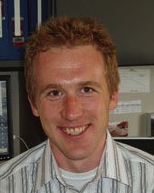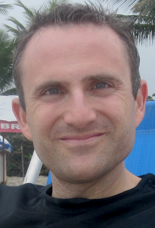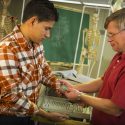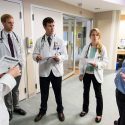Class explores worldwide picture for AIDS, HIV
“This is an important time in HIV research,” Matt Reynolds, an HIV researcher at University of Wisconsin–Madison, tells an undergraduate class on the Monday morning after Thanksgiving.

Reynolds
The class is taught by six researchers, and when many of them entered the field in the 1990s, the first drugs to anti-retroviral drugs were just starting to prove their value. But the drugs were extremely expensive, Reynolds says, “and there was a real debate about whether they would be distributed to low-income countries.”
And it is in those countries, especially in sub-Saharan Africa, that the majority of the estimated 34 million HIV infections are now found.
But due in no small measure to a generous American program proposed by President George W. Bush, “Eight million people around the world on anti-retrovirals,” Reynolds says. Advances in treatment, combined with some progress in vaccines and a better understanding of infection prevention, have given rise to a new goal: an “AIDS-free generation.”
It’s the week before World AIDS Day (Saturday, Dec. 1), and 100 students in Pathology/Pathobiological Sciences 210: HIV: Sex, Society, and Science, are getting up to speed on the state of the pandemic.
The students are too young to remember AIDS as the uniformly fatal disease of the 1980s and early 1990s. But that misses the point, says co-leader David O’Connor, who studies immune system genetics and HIV in the Department of Pathology and Laboratory Medicine in the School of Medicine and Public Health. “We made the strategic decision to cover the history, but we really want them to understand the dimensions of the epidemic today.” The majority of infections are in sub-Saharan Africa, “and it’s enough of a challenge to get them to understand something that is half a world away.”

Friedrich
Since the 1980s, AIDS and HIV have sparked an explosion of interest in infectious disease and immunology, says class co-leader Thomas Friedrich, of the Department of Pathobiological Sciences in the School of Veterinary Medicine. “To understand HIV pathogenesis, scientists had to learn a lot about immunology,” especially regarding the T-cells that direct the immune system to destroy virus-infected cells, says Friedrich, who studies how viruses like HIV and influenza evolve to evade the immune system.
HIV kills T-cells, leading to the deadly opportunistic infections that are the hallmark of AIDS.
In the past decade or so, lab and field studies have shown that infection can be blocked by, for example, treating pregnant mothers before birth so their newborns will be HIV negative. Although HIV can be controlled by a series of drugs, the virus is disturbingly quick to evolve. Much as bacteria are evolving resistance to antibiotics, HIV could evolve immunity to anti-viral drugs and eliminate decades of progress, says O’Connor. “This virus has the ability to change, but we don’t know what the risk of widespread drug resistance will be.”
Most of the AIDS research at UW–Madison has occurred with key support from the Wisconsin National Primate Research Center.

O’Connor
Even though progress toward an AIDS vaccine has been painfully slow, at least one candidate vaccine has produced some protection, O’Connor says. “A vaccine would truly be a transformative intervention that could eradicate HIV or dramatically limit its spread. A vaccine remains the moonshot of AIDS research.”
The class is unique in its reliance on working researchers from around the world as teachers, O’Connor says.
“This is a class about HIV, but it’s also about critical thinking, about using the scientific method to conceptualize a complex problem, where students have to identify hypotheses, then test and refine them,” O’Connor adds.
Beyond that, the class has even influenced some career decisions, says Friedrich. “After virtually every semester, one or two students contact us to say, ‘I took your class, and I wanted you know I was going to be an English major and decided to go to medical school.’ Or, ‘I was in international relations, and I started a fellowship in HIV prevention at an NGO in Washington.”
Indeed, Robert Kueffer, a sophomore, says the current class “is why I am going to get the global health certificate” at UW–Madison.
“I have always thought I’d do business, make money, but this is something that really affects people. I like that the class covers the science, but is not overwhelmingly scientific, and it also covers the social effects. You feel like the teachers really want you to learn,” Kueffer says.
Those messages matter, says Friedrich. “As much as I enjoy research, and it’s the focus of my career, hearing that this class played a role in shaping what students want to do with their lives, and in their desire to make the world a better place, is honestly the most immediately rewarding thing I do.”



